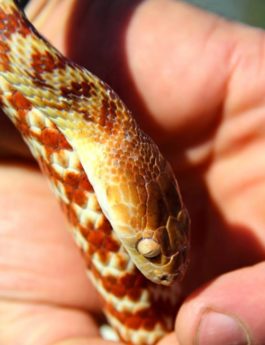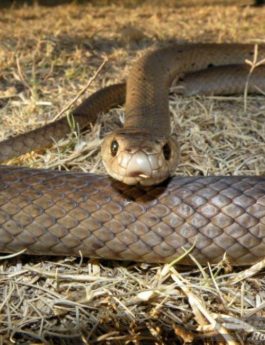The Pilbara Death Adder is a bright reddish to dark brown with a series of irregular cross-bands formed by paler, usually yellow scales; among both colours are scattered dark brown scales. The paler cross-bands may have their hind edges marked by black-tipped scales, most dorsal scales are strongly keeled. Like other death adders their body shape is distinctive, with a broad triangular head, short narrow neck, short stout body, and a thin tail ending in a curved soft spine. Tail tip usually yellow but sometimes blackish. Their belly is cream or a reddish colour. This snake is DANGEROUS.
You will find the Pilbara Death Adder in a variety of arid habitats in the Pilbara region WA, from stony ranges to sandy habitats with spinifex and Acacia scrublands.
Terrarium: Death Adders do not require an enclosure with very much height, however if given the correct environment with climbing enrichment they will explore their enclosure. The enclosure needs to be large enough to provide multiple hide rocks and maintain a thermal gradient, a terrarium that is 60x45x45cm (WxDxH) would be suitable to house a mature Death Adder. Terrarium’s must be lockable and escape proof.
Lighting & heating: UVB lighting is not essential to Death Adders, however a low 2.0 spectrum fluorescent globe can be used for viewing purposes. Heating can be provided with a heat tile, mat or cord to maintain a ground surface temperature of 32°C in the hot spot. Ambient heat can be provided with an infrared heat globe to maintain a daytime temperature of 36°C in the warm end and 25°C in the cool end, on warmer days you may not need to turn on the heat globe as the ambient temperature of the enclosure may already be high enough. A thermometer should always be used to monitor the temperature within the enclosure.
Furnishings: It is important to provide your Death Adder with a hide cave in the warm end, a water bowl at the cool end, and artificial plants will give coverage and decoration. Large Logs and vines can be used within the enclosure to provide climbing enrichment. A pet bedding wood chips such as Chipsi or Critter Crumble can be used as a substrate. It is important to keep the enclosure basic and easy to maintain, as a cluttered terrarium can make it very dangerous when you need to remove your venomous snake from the enclosure for any reason.
Food in captivity: All snakes in captivity must be fed dead food. A Death Adder will eat a variety of frozen and thawed mice, rats and chickens of appropriate sizes. On average they will have 1-2 food items every 7-10 days.
The essentials:
- Terrarium of appropriate size
- Tummy heating
- Thermometer
- Infrared Heat globe
- Water bowl
- Substrate
- Hide cave





